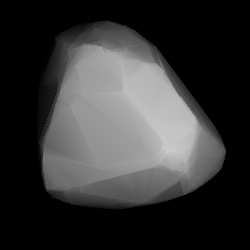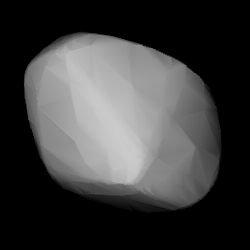
Freia is a very large main-belt asteroid. It orbits in the outer part of the asteroid belt and is classified as a Cybele asteroid. Its composition is very primitive and it is extremely dark in color. Freia was discovered by the astronomer Heinrich d'Arrest on October 21, 1862, in Copenhagen, Denmark. It was his first and only asteroid discovery. It is named after the goddess Freyja in Norse mythology.

Semele is a large and very dark main-belt asteroid with an orbital period of 5.5 years. It is rotating with a period of 16.6 hours, and varies in magnitude by 0.13 during each cycle. This object is classified as a C-type asteroid and is probably composed of carbonates.

Nemesis is a large 180 km main-belt asteroid, of carbonaceous composition. It rotates rather slowly, taking about 78 hours to complete one rotation. Nemesis is the largest member of the Nemesian asteroid family bearing its name. It was discovered by J. C. Watson on 25 November 1872, and named after Nemesis, the goddess of retribution in Greek mythology.

Hilda is a large asteroid in the outer main belt, with a diameter of 170 km. The spectrum matches that of a P-type asteroid. It was discovered by Johann Palisa on 2 November 1875, from the Austrian Naval Observatory at Pula, now Croatia. The name was chosen by the astronomer Theodor von Oppolzer, who named it after one of his daughters.

Una is a fairly large and dark, primitive Main belt asteroid that was discovered by German-American astronomer C. H. F. Peters on February 20, 1876, in Clinton, New York. It is named after a character in Edmund Spenser's epic poem The Faerie Queene (1590).

175 Andromache is a main-belt asteroid that was discovered by Canadian-American astronomer J. C. Watson on October 1, 1877, and named after Andromache, wife of Hector during the Trojan War. Watson's telegram to Europe announcing the discovery became lost, and so notification did not arrive until several weeks later. As a result, another minor planet, later designated 176 Iduna, was initially assigned the number 175.

229 Adelinda is a large, dark outer main-belt asteroid. It was discovered by Austrian astronomer Johann Palisa on August 22, 1882, in Vienna, and was named after Adelinda, the wife of fellow Austrian astronomer Edmund Weiss.

Huberta is a large asteroid orbiting near the outer edge of the Main belt. It is dark and rich in carbon.

Nephthys is a large Main belt asteroid that was discovered by German-American astronomer C. H. F. Peters on August 25, 1889, in Clinton, New York and named after the goddess, Nephthys in Egyptian mythology. It is classified as an S-type asteroid.

Bavaria is a carbonaceous background asteroid from the intermediate asteroid belt, approximately 54 kilometers. It was discovered by Johann Palisa on 16 November 1890 in Vienna.

Gisela is an asteroid belonging to the Flora family in the Main Belt that has an unusually high albedo.

Arsinoë, minor planet designation 404 Arsinoë, is a large main-belt asteroid. It is classified as a C-type asteroid and is probably composed of carbonaceous material.
1038 Tuckia, provisional designation 1924 TK, is rare-type Hilda asteroid from the outermost regions of the asteroid belt, approximately 58 kilometers in diameter. It was discovered on 24 November 1924, by German astronomer by Max Wolf at Heidelberg Observatory in southwest Germany. The asteroid was named after American banker Edward Tuck and his wife.
2067 Aksnes, provisional designation 1936 DD, is a rare-type Hildian asteroid from the outermost region of the asteroid belt, approximately 44 kilometers in diameter. The asteroid was discovered on 23 February 1936, by Finnish astronomer Yrjö Väisälä at Turku Observatory in Southwest Finland. It was named after astronomer Kaare Aksnes.
3290 Azabu, provisional designation 1973 SZ1, is a dynamical Hildian asteroid from the outermost regions of the asteroid belt, approximately 10–20 kilometers (6–10 miles) in diameter. It was discovered on 19 September 1973, by Dutch astronomers Ingrid and Cornelis van Houten at Leiden, and Tom Gehrels the Palomar Observatory. The asteroid has a rotation period of 7.67 hours. It was named after the former city district of Tokyo, Azabu.
1529 Oterma, provisional designation 1938 BC, is a reddish, rare-type Hildian asteroid from the outermost region of the asteroid belt, approximately 56 kilometers in diameter. It was discovered on 26 January 1938, by Finnish astronomer Yrjö Väisälä at Turku Observatory in Southwest Finland. It is named for Liisi Oterma.
1345 Potomac, provisional designation 1908 CG, is a dark Hildian asteroid from the outermost regions of the asteroid belt, approximately 73 kilometers (45 mi) in diameter. It was discovered on 4 February 1908, by American astronomer Joel Metcalf at the Taunton Observatory in Massachusetts, United States. The X-type asteroid has a rotation period of 11.4 hours. It was named for the Potomac River on which Washington, D.C. is located.

1902 Shaposhnikov is a dark Hilda asteroid from the outermost region of the asteroid belt, approximately 92 kilometers in diameter. It was discovered on 18 April 1972, by Russian astronomer Tamara Smirnova at the Crimean Astrophysical Observatory in Nauchnyj, on the Crimean peninsula. The asteroid was named after Soviet astronomer and WWII casualty Vladimir Shaposhnikov. It was one of the last larger asteroids discovered in the main belt.
51983 Hönig, provisional designation 2001 SZ8, is a Hildian asteroid from the outermost regions of the asteroid belt, approximately 13 kilometers in diameter. It was discovered on 19 September 2001, by astronomers Charles Juels and Paulo Holvorcem at the Fountain Hills Observatory (678) in Arizona, United States. The asteroid was named after German astronomer Sebastian Hönig.
(457175) 2008 GO98, provisional designation 2008 GO98 with cometary number 362P, is a Jupiter family comet in a quasi-Hilda orbit within the outermost regions of the asteroid belt. It was discovered on 8 April 2008, by astronomers of the Spacewatch program at Kitt Peak National Observatory near Tucson, Arizona, in the United States. This presumably carbonaceous body has a diameter of approximately 15 kilometers (9 miles) and rotation period of 10.7 hours.













